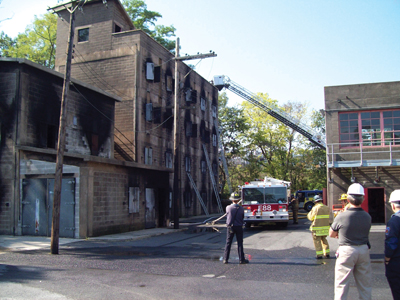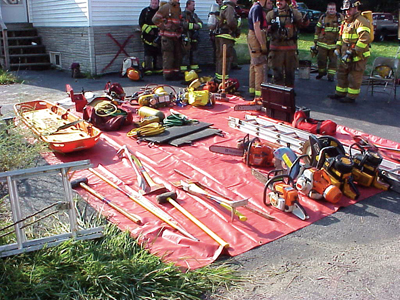
Features
Structural
Training
Back to basics: RIT staging and procedures
In January, we discussed when to implement a rapid intervention team. Now, we will consider where the RIT will be staged and some procedures to follow.
March 27, 2009
By Mark van der Feyst
In January, we discussed when to implement a rapid intervention team. Now, we will consider where the RIT will be staged and some procedures to follow.
 |
|
| Photo by Mark van der Feyst. Notice the laddering of the windows in this training exercise.
|
Every department operates differently. Some want the RIT located far away from the scene, some want it near the incident commander and some don’t know where to put the RIT. I have been exposed to all three of these situations over the years. At one fire department, it was policy to have the RIT at the command post. This was done to ensure good communication between the IC and the RIT officer. The drawback to this is that if the command post is far away from the scene then the RIT is also far away from the scene. Staging the RIT with the IC works when the IC is located right at the scene. Another department I worked for places the RIT wherever there is room or wherever it will be out of the way. This is the afterthought model of RIT staging and does not work because consideration for the RIT staging is a last resort rather than a priority.
Staging the RIT should be strategic, not by chance. When an officer arrives on scene, he should consider where to stage the various pieces of equipment, apparatus and operations to effectively combat the fire. The RIT is a part of the operations and equipment portion of the size-up. Strategically placing the RIT will increase the response capability and allow the team to conduct its operations (size-up, progressive fire-ground preparations). Depending on the size of the building and the stage of fire growth, there may be a need to stage the RIT in two, three or four different locations.
I can remember a call we went to on a hot and humid August day. We responded to a possible structure fire as the RIT. There had been a thunder and lightning storm in the area and the house had been struck by lightning. Once we arrived on scene our officer in charge met with the IC and got a quick report of the situation. There were flames visible and the crews inside were on an offensive fire attack. Our officer decided to place us at the four corners of the house. We were split into teams of four because there were offensive operations taking place all around the house. Our best access for a quick response was to be at the four corners of the house. Our officer sized up the situation and, based upon strategy, staged us in the appropriate positions. It might have been easier to stage us in one location near the truck or by the street but that would have been a “chance” staging choice.
So you have arrived on scene. Now what do you do? Well, the officer in charge should report to the area of the IC in front of the building and remain in visual/verbal contact with the IC or safety officer at all times. The initial meeting with the IC is to receive an update on the situation. At this point, the IC can designate the staging area or the officer may be elected to decide that. Usually the IC allows the officer to decide the best location for staging. Once staged, the officer needs to stay in contact with the IC. This can be accomplished either visually or by radio communication. The IC or safety officer should update the RIT officer on numbers of personnel in the building at all times. If the IC or safety officer is not updating the RIT, then the RIT officer should be asking.
 |
|
| Photo courtesy PSFA. RIT staging is up the incident commander and should be close to the scene. |
Once staged at the preferred location, the RIT now needs to bring all its tools to the staging area. Too often the RIT gets caught off guard because it left equipment on the truck. The equipment needs to be where the RIT is. (Remember that we discussed in October the tools of RIT.)
The primary task of the RIT is to respond to any firefighter in distress, caught in a collapse, lost or disoriented, out of air or in a flashover/backdraft. The RIT is not supplemental manpower for advancing hoselines, conducting salvage operations, filling air bottles or conducting rehab. The RIT is there to rescue firefighters. I have seen the RIT assigned different tasks by the IC. If the RIT is busy setting up the aerial and a mayday call comes in, how effective will the response be? The RIT needs to be ready at a moment’s notice. On that hot, humid August day when I was a part of the RIT for the structure fire, we were positioned to respond and we stood or knelt on one knee for about an hour in the humidity. We were ready to respond; it was boring watching the offensive operation but it was necessary to ensure a quick, rapid response. When the IC needed more manpower for different operations, he called in mutual aid – he did not resort to using the RIT.
The team must monitor the fire ground frequency at all times. You may get only one chance to hear a mayday over the radio. If RIT members are too busy setting up the aerial, they may miss that call. Being on the RIT doesn’t mean you are on break. You need to be proactive and attentive to what is going on around you. This takes concentration and dedication. (See sidebar below.)
We need to teach firefighters to call for help and declare a mayday even if they just feel like they’re in trouble. If they wait until the last minute to declare a mayday, when they know they are in trouble, it will be too late. Give your location, your condition, the number of people in your crew, your air situation and the fire conditions present around you. Activate your PASS alarm, assume a position that will maximize audible effects. Try to conserve air supply by remaining calm; use skip breathing or controlled breaths. Attempt to find a way out. Do not sit there and wait for the RIT to rescue you. Do something to save yourself. If we teach these basic principles to every firefighter, it will help rapid intervention teams in their efforts to rescue you.
Staging the RIT is an important function that should be looked at from a strategic perspective; once staged, team members need to be proactive. Remember, the team’s job is to rescue firefighters. Don’t just stand around and wait for a tragedy to occur; help to prevent one by removing potential hazards. Be proactive!
Mark van der Feyst began his career in the fire service in 1998 with the Cranberry Township Volunteer Fire Company, Station 21, in Pennsylvania. He served as a firefighter and training officer for four years, then joined the Mississauga Fire & Emergency Services, where he served for three years as a firefighter and shift medical instructor. He is now with the City of Woodstock Fire Department in Ontario.
| How can RIT members be proactive? • Conduct a 360-degree walk around; locate all entrances and exits and ensure they are accessible by both firefighters and the RIT. • Place ground ladders at all windows. This gives access for the RIT as well as an escape route for the firefighters inside. • Set up a safety hose-line for the RIT. If we need a hose-line for our operations, relying on the engine company to supply it is not guaranteed. • Know what type of building construction you are dealing with. This will give the RIT some insight on what is happening on the inside and allow the team to predict fire behaviour and growth. If the RIT needs to go in, knowing the type of building construction will help in making entry and exit through enlarged openings. • Be aware of the accountability system. Knowing how many firefighters are on the inside, and their positions, will give the RIT a leg up on the situation. • Monitor fire conditions. This will help the RIT keep ahead of the game. • Assume the worst. If you are the RIT leader and you have been deployed, this will prepare you for the unexpected. If you respond ready for the worst, you will be ahead of the game; respond not prepared for the worst, and you will be caught off guard. • Consider last known location of the firefighter. This information can be supplied by the IC or by accountability. Either way, it should be determined. • Listen – radio, tapping, PASS, screams. This may lead you quickly to the location of the firefighter. • Trace hoseline if one was used. This will also lead you to the location of the firefighter. • Open all exits to ensure that a way in and out is secure and accessible. • Provide for rapid ventilation. This will increase your visibility; will provide some relief for the firefighter and the RIT. |
Print this page